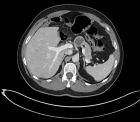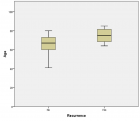Abstract
Mini Review
Potential of Herbarium-based Phenological Studies to Predict the Climate Change Impacts
Kailash S Gaira*, OK Belwal and ID Bhatt
Published: 24 July, 2024 | Volume 8 - Issue 2 | Pages: 110-112
Herbarium records provide a valuable historical database for assessing plant phenology shifts in the context of global climate change. The herbarium specimens, collected from diverse locations and periods, offer comprehensive data illustrating how many plants are altering their blooming times in response to global climate change. The appropriate use and analysis of long-term herbarium records offer an additional dimension for the study of plant phenology through the application of advanced experimental methodologies such as bioinformatics and satellite imagery, statistics, and Artificial Intelligence (AI) which, coupled with field observations, will improve ecosystems evaluation. These efforts can significantly contribute to conservation strategies and climate change mitigation and further support the synchronization of scientific inputs for evaluating the impacts of climate change and its ecological implications.
Read Full Article HTML DOI: 10.29328/journal.jpsp.1001141 Cite this Article Read Full Article PDF
Keywords:
Citizen science; Climate change; Herbarium records; Phenology; Statistical tools
References
- Primack D, Imbres C, Primack RB, Miller-Rushing AJ, Tredici PD. Herbarium specimens demonstrate earlier flowering time in response to warming in Boston. Am J Bot. 2004;91:1260-1264. Available from: http://dx.doi.org/10.3732/ajb.91.8.1260
- Bolmgren K, Lonnberg K. Herbarium data reveal an association between fleshy fruit type and earlier flowering time. Int J Plant Sci. 2005;166:663-670. Available from: https://doi.org/10.1086/430097
- Miller-Rushing AJ, Primack RB, Primack D, Mukunda S. Photographs and herbarium specimens as tools to document phenological changes in response to global warming. Am J Bot. 2006;93:1667-1674. Available from: http://dx.doi.org/10.3732/ajb.93.11.1667
- Gallagher RV, Hughes L, Leishman MR. Phenological trends among Australian alpine species: using herbarium records to identify climate-change indicators. Aust J Bot. 2009;57:1-9. Available from: https://doi.org/10.1071/BT08051
- Neil KL, Landrum L, Wu J. Effects of urbanization on flowering phenology in the metropolitan phoenix region of USA: findings from herbarium records. J Arid Environ. 2010;74:440-444. Available from: http://leml.asu.edu/jingle/Wu-Publications-PDFs/2010/Neil_etal-2010-Urbanztn+phenology+herbariumRcds.pdf
- Robbirt KM, Davy AJ, Hutchings MJ, Roberts DL. Validation of biological collections as a source of phenological data for use in climate change studies: a case study with the orchid Ophrys sphegodes. J Ecol. 2011;99:235-241.
- Gaira KS, Rawal RS, Rawat B, Bhatt ID. Impact of climate change on the flowering of Rhododendron arboreum in central Himalaya, India. Curr Sci. 2014;106:1735-1738.
- Davis CC, Willis CG, Connolly B, Kelly C, Ellison AM. Herbarium records are reliable sources of phenological change driven by climate and provide novel insights into species’ phenological cueing mechanisms. Am J Bot. 2015;102:1-11. Available from: https://doi.org/10.3732/ajb.1500237
- Park DS, Lyra GM, Ellison AM, Maruyama RKB, Torquato DDR, Asprino RC, et al. Herbarium records provide reliable phenology estimates in the understudied tropics. J Ecol. 2022. Available from: https://harvardforest.fas.harvard.edu/sites/default/files/ellison-pubs/2021/Park_etal2023-JEcol.pdf
- Hassan T, Gulzar R, Hamid M, Ahmad R, Waza SA, Khuropo AA. Plant phenology shifts under climate warming: a systematic review of recent scientific literature. Environ Monit Assess. 2024;196:36. Available from: https://doi.org/10.1007/s10661-023-12190-w
- Gaira KS, Dhar U, Belwal OK. Potential of herbarium records to sequence phenological pattern–a case study of Aconitum heterophyllum Wall. in the Himalaya. Biodivers Conserv. 2011;20:2201-2210. Available from: http://dx.doi.org/10.1007/s10531-011-0082-4
- Banaszak C, Grinath JB, Herlihy CR. Chilling consequences: Herbarium records reveal earlier reproductive phenology of winter annual gladecress in a wetter, cooler climate. Plants People Planet. 2020;2:340-352. Available from: https://doi.org/10.1002/ppp3.10095
- Gaira KS, Dhar U. Phenological change modelling for selected Himalayan medicinal herbs using herbarium records: A case study. Ecol Inform. 2020;60:101177. Available from: http://dx.doi.org/10.1016/j.ecoinf.2020.101177
- Ahlstrand NI, Primack RB, Tøttrup AP. Correction to: A comparison of herbarium and citizen science phenology datasets for detecting response of flowering time to climate change in Denmark. Int J Biometeorol. 2022;66:863. Available from: https://link.springer.com/article/10.1007/s00484-022-02272-8
- Khan S, Gaira KS, Asgher M, Verma S, Pant S, Agrawala DK, et al. Temperature Induced Flowering Phenology of Olea ferruginea Royle: A Climate Change Effect. Sustainability. 2023;15:6936. Available from: https://doi.org/10.3390/su15086936
- Park IW, Ramirez-Parada T, Record S, Davis C, Ellison AM, Mazer SJ. Data from: Herbarium data accurately predict the timing and duration of population-level flowering displays. Dryad Digital Repository. 2024.
- Freimuth J, Bossdorf O, Scheepens JF, Willems FM. Climate warming changes synchrony of plants and pollinators. Proc Biol Sci. 2022;289:20212142. Available from: https://doi.org/10.1098/rspb.2021.2142
- Stucky BJ, Guralnick R, Deck J, Denny EG, Bolmgren K, Walls R. The Plant Phenology Ontology: A New Informatics Resource for Large-Scale Integration of Plant Phenology Data. Front Plant Sci. 2018;9:517. Available from: https://doi.org/10.3389/fpls.2018.00517
- Park IW. Digital herbarium archives as a spatially extensive, taxonomically discriminate phenological record; a comparison to MODIS satellite imagery. Int J Biometeorol. 2012;56:1179-1182. Available from: https://doi.org/10.1007/s00484-012-0521-2
Figures:
Similar Articles
-
Current challenges in plant breeding to achieve zero hunger and overcome biotic and abiotic stresses induced by the global climate changes: A reviewGniech Karasawa Marines Marli*. Current challenges in plant breeding to achieve zero hunger and overcome biotic and abiotic stresses induced by the global climate changes: A review. . 2021 doi: 10.29328/journal.jpsp.1001060; 5: 053-057
-
Tree-ring history of Swiss needle cast impact on Douglas-fir growth in Western Oregon: correlations with climatic variablesE Henry Lee*,Peter A Beedlow,Ronald S Waschmann,Steve Cline,Michael Bollman,Charlotte Wickham,Nicholas Testa. Tree-ring history of Swiss needle cast impact on Douglas-fir growth in Western Oregon: correlations with climatic variables. . 2021 doi: 10.29328/journal.jpsp.1001065; 5: 076-087
-
Mitigation and adaptation to climate change of plant pathogensFrancesco Lops*. Mitigation and adaptation to climate change of plant pathogens. . 2022 doi: 10.29328/journal.jpsp.1001082; 6: 101-102
-
Bees, Butterflies, and Beyond the Diverse Pollinators, an Essence for the Reproductive Success of Flowering PlantsAmmir Hassan*, Shamiya Hassan, Mohd Abdul Nasir. Bees, Butterflies, and Beyond the Diverse Pollinators, an Essence for the Reproductive Success of Flowering Plants. . 2024 doi: 10.29328/journal.jpsp.1001135; 8: 065-073
-
Potential of Herbarium-based Phenological Studies to Predict the Climate Change ImpactsKailash S Gaira*, OK Belwal, ID Bhatt. Potential of Herbarium-based Phenological Studies to Predict the Climate Change Impacts. . 2024 doi: 10.29328/journal.jpsp.1001141; 8: 110-112
Recently Viewed
-
Parents’ perception of the school nurse’s roleDiane Gillooly*,Ganga Mahat,Patricia Paradiso. Parents’ perception of the school nurse’s role. J Adv Pediatr Child Health. 2020: doi: 10.29328/journal.japch.1001021; 3: 064-067
-
Plant growth, Yield and Leaf Nutritional value of Jute (Corchorus olitorius L.) as Influenced by Banana Peel levels under Salt Stress conditions in Coastal region of CameroonMathias Julien Hand*,Chimène Fanta Abib,Kingsley Mbi Tabi,Alphonse Ervé Nouck,Libert Brice Tonfack,Victor Désiré Taffouo,Emmanuel Youmbi. Plant growth, Yield and Leaf Nutritional value of Jute (Corchorus olitorius L.) as Influenced by Banana Peel levels under Salt Stress conditions in Coastal region of Cameroon. J Plant Sci Phytopathol. 2024: doi: 10.29328/journal.jpsp.1001145; 8: 131-140
-
Dynamics of Siberian Fir Stands in Forest Ecosystems of Eastern Sayan SpursBazhina Elena Vasil’evna*,Pavel I Aminev. Dynamics of Siberian Fir Stands in Forest Ecosystems of Eastern Sayan Spurs. J Plant Sci Phytopathol. 2024: doi: 10.29328/journal.jpsp.1001146; 8: 141-143
-
Minimising Carbon Footprint in Anaesthesia PracticeNisha Gandhi and Abinav Sarvesh SPS*. Minimising Carbon Footprint in Anaesthesia Practice. Int J Clin Anesth Res. 2024: doi: 10.29328/journal.ijcar.1001025; 8: 005-007
-
Survey of Advanced Image Fusion Techniques for Enhanced Visualization in Cardiovascular Diagnosis and TreatmentGargi J Trivedi*. Survey of Advanced Image Fusion Techniques for Enhanced Visualization in Cardiovascular Diagnosis and Treatment. J Clin Med Exp Images. 2025: doi: 10.29328/journal.jcmei.1001034; 9: 001-009
Most Viewed
-
Evaluation of Biostimulants Based on Recovered Protein Hydrolysates from Animal By-products as Plant Growth EnhancersH Pérez-Aguilar*, M Lacruz-Asaro, F Arán-Ais. Evaluation of Biostimulants Based on Recovered Protein Hydrolysates from Animal By-products as Plant Growth Enhancers. J Plant Sci Phytopathol. 2023 doi: 10.29328/journal.jpsp.1001104; 7: 042-047
-
Sinonasal Myxoma Extending into the Orbit in a 4-Year Old: A Case PresentationJulian A Purrinos*, Ramzi Younis. Sinonasal Myxoma Extending into the Orbit in a 4-Year Old: A Case Presentation. Arch Case Rep. 2024 doi: 10.29328/journal.acr.1001099; 8: 075-077
-
Feasibility study of magnetic sensing for detecting single-neuron action potentialsDenis Tonini,Kai Wu,Renata Saha,Jian-Ping Wang*. Feasibility study of magnetic sensing for detecting single-neuron action potentials. Ann Biomed Sci Eng. 2022 doi: 10.29328/journal.abse.1001018; 6: 019-029
-
Pediatric Dysgerminoma: Unveiling a Rare Ovarian TumorFaten Limaiem*, Khalil Saffar, Ahmed Halouani. Pediatric Dysgerminoma: Unveiling a Rare Ovarian Tumor. Arch Case Rep. 2024 doi: 10.29328/journal.acr.1001087; 8: 010-013
-
Physical activity can change the physiological and psychological circumstances during COVID-19 pandemic: A narrative reviewKhashayar Maroufi*. Physical activity can change the physiological and psychological circumstances during COVID-19 pandemic: A narrative review. J Sports Med Ther. 2021 doi: 10.29328/journal.jsmt.1001051; 6: 001-007

HSPI: We're glad you're here. Please click "create a new Query" if you are a new visitor to our website and need further information from us.
If you are already a member of our network and need to keep track of any developments regarding a question you have already submitted, click "take me to my Query."


















































































































































